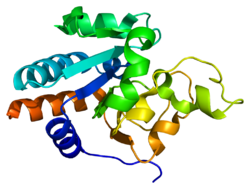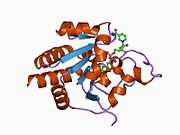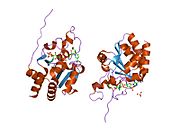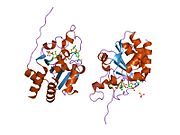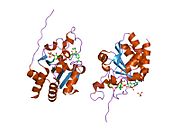- NNT (gene)
-
NAD(P) transhydrogenase, mitochondrial is an enzyme that in humans is encoded by the NNT gene.[1][2][3]
This gene encodes an integral protein of the inner mitochondrial membrane. The enzyme couples hydride transfer between NAD(H) and NADP(+) to proton translocation across the inner mitochondrial membrane. Under most physiological conditions, the enzyme uses energy from the mitochondrial proton gradient to produce high concentrations of NADPH. The resulting NADPH is used for biosynthesis and in free radical detoxification. Two alternatively spliced variants, encoding the same protein, have been found for this gene.[3]
References
- ^ Arkblad EL, Helou K, Levan G, Rydstrom J (Oct 1997). "Mapping of the rat and mouse nicotinamide nucleotide transhydrogenase gene". Mamm Genome 8 (9): 703. doi:10.1007/s003359900546. PMID 9271681.
- ^ Zieger B, Ware J (May 1998). "Cloning and deduced amino acid sequence of human nicotinamide nucleotide transhydrogenase". DNA Seq 7 (6): 369–73. doi:10.3109/10425179709034058. PMID 9524818.
- ^ a b "Entrez Gene: NNT nicotinamide nucleotide transhydrogenase". http://www.ncbi.nlm.nih.gov/sites/entrez?Db=gene&Cmd=ShowDetailView&TermToSearch=23530.
Further reading
- Jackson JB (2003). "Proton translocation by transhydrogenase". FEBS Lett. 545 (1): 18–24. doi:10.1016/S0014-5793(03)00388-0. PMID 12788487.
- Arkblad EL, Betsholtz C, Rydström J (1996). "The cDNA sequence of proton-pumping nicotinamide nucleotide transhydrogenase from man and mouse". Biochim. Biophys. Acta 1273 (3): 203–5. doi:10.1016/0005-2728(95)00159-X. PMID 8616157.
- Forsmark-Andrée P, Persson B, Radi R, et al. (1997). "Oxidative modification of nicotinamide nucleotide transhydrogenase in submitochondrial particles: effect of endogenous ubiquinol". Arch. Biochem. Biophys. 336 (1): 113–20. doi:10.1006/abbi.1996.0538. PMID 8951041.
- White SA, Peake SJ, McSweeney S, et al. (2000). "The high-resolution structure of the NADP(H)-binding component (dIII) of proton-translocating transhydrogenase from human heart mitochondria". Structure 8 (1): 1–12. doi:10.1016/S0969-2126(00)00075-7. PMID 10673423.
- Peake SJ, Jackson JB, White SA (2000). "The NADP(H)-binding component (dIII) of human heart transhydrogenase: crystallization and preliminary crystallographic analysis". Acta Crystallogr. D Biol. Crystallogr. 56 (Pt 4): 489–91. doi:10.1107/S0907444900001542. PMID 10739929.
- Hartley JL, Temple GF, Brasch MA (2001). "DNA Cloning Using In Vitro Site-Specific Recombination". Genome Res. 10 (11): 1788–95. doi:10.1101/gr.143000. PMC 310948. PMID 11076863. http://www.pubmedcentral.nih.gov/articlerender.fcgi?tool=pmcentrez&artid=310948.
- Venter JC, Adams MD, Myers EW, et al. (2001). "The sequence of the human genome". Science 291 (5507): 1304–51. doi:10.1126/science.1058040. PMID 11181995.
- Wiemann S, Weil B, Wellenreuther R, et al. (2001). "Toward a Catalog of Human Genes and Proteins: Sequencing and Analysis of 500 Novel Complete Protein Coding Human cDNAs". Genome Res. 11 (3): 422–35. doi:10.1101/gr.GR1547R. PMC 311072. PMID 11230166. http://www.pubmedcentral.nih.gov/articlerender.fcgi?tool=pmcentrez&artid=311072.
- Arkblad EL, Egorov M, Shakhparonov M, et al. (2003). "Expression of proton-pumping nicotinamide nucleotide transhydrogenase in mouse, human brain and C elegans". Comp. Biochem. Physiol. B, Biochem. Mol. Biol. 133 (1): 13–21. doi:10.1016/S1096-4959(02)00107-0. PMID 12223207.
- Strausberg RL, Feingold EA, Grouse LH, et al. (2003). "Generation and initial analysis of more than 15,000 full-length human and mouse cDNA sequences". Proc. Natl. Acad. Sci. U.S.A. 99 (26): 16899–903. doi:10.1073/pnas.242603899. PMC 139241. PMID 12477932. http://www.pubmedcentral.nih.gov/articlerender.fcgi?tool=pmcentrez&artid=139241.
- Taylor SW, Fahy E, Zhang B, et al. (2003). "Characterization of the human heart mitochondrial proteome". Nat. Biotechnol. 21 (3): 281–6. doi:10.1038/nbt793. PMID 12592411.
- Gerhard DS, Wagner L, Feingold EA, et al. (2004). "The Status, Quality, and Expansion of the NIH Full-Length cDNA Project: The Mammalian Gene Collection (MGC)". Genome Res. 14 (10B): 2121–7. doi:10.1101/gr.2596504. PMC 528928. PMID 15489334. http://www.pubmedcentral.nih.gov/articlerender.fcgi?tool=pmcentrez&artid=528928.
- Wiemann S, Arlt D, Huber W, et al. (2004). "From ORFeome to Biology: A Functional Genomics Pipeline". Genome Res. 14 (10B): 2136–44. doi:10.1101/gr.2576704. PMC 528930. PMID 15489336. http://www.pubmedcentral.nih.gov/articlerender.fcgi?tool=pmcentrez&artid=528930.
- Kimura K, Wakamatsu A, Suzuki Y, et al. (2006). "Diversification of transcriptional modulation: Large-scale identification and characterization of putative alternative promoters of human genes". Genome Res. 16 (1): 55–65. doi:10.1101/gr.4039406. PMC 1356129. PMID 16344560. http://www.pubmedcentral.nih.gov/articlerender.fcgi?tool=pmcentrez&artid=1356129.
- Mehrle A, Rosenfelder H, Schupp I, et al. (2006). "The LIFEdb database in 2006". Nucleic Acids Res. 34 (Database issue): D415–8. doi:10.1093/nar/gkj139. PMC 1347501. PMID 16381901. http://www.pubmedcentral.nih.gov/articlerender.fcgi?tool=pmcentrez&artid=1347501.
PDB gallery 1d4o: CRYSTAL STRUCTURE OF TRANSHYDROGENASE DOMAIN III AT 1.2 ANGSTROMS RESOLUTION1djl: THE CRYSTAL STRUCTURE OF HUMAN TRANSHYDROGENASE DOMAIN III WITH BOUND NADP1pt9: Crystal Structure Analysis of the DIII Component of Transhydrogenase with a Thio-Nicotinamide Nucleotide Analogue1u31: recombinant human heart transhydrogenase dIII bound with NADPHCategories:- Human proteins
- Chromosome 5 gene stubs
Wikimedia Foundation. 2010.

